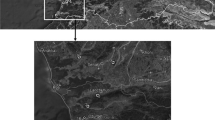Abstract
This study aimed to investigate the damage potential of two hemipteran species that are commonly recorded in citrus orchards of the eastern Mediterranean region. These were Closterotomus trivialis Costa and Aphanosoma italicum Costa (Hemiptera: Miridae). Shoots on sweet orange trees were enclosed in muslin cages into each of which eight nymphs or eight adults were introduced not only in the early development of the buds but also in the different stages of the flowering period in 2008 (i.e., 6 and 19 March, 10 April and 2 May). In the experiments, adults of C. trivialis, and nymphs and adults of A. italicum were used. According to the results, in a few cases these insects caused a significant reduction in the number of buds or flowers and fruits dropped in comparison to the controls. However, the number of fruits that finally remained on the trees was not significantly affected. Therefore, the damage potential of these mirids on the fruit production of citrus was not shown to be significant under our experimental conditions.



Similar content being viewed by others
References
Barbagallo S (1970) Contributo alla conoscenza del Calocoris (Closterotomus) triviales (Costa) (Rhynchota-Heteroptera, Miridae). Entomologica (Bari) 6:1–104
Gerakaki KP, Kalaitzaki AP, Varikou KN, Alexandrakis VZ (2007) Calocoris trivialis Costa (Hemiptera: Miridae) a pest of olive orchards of country of Chania, In: Proceedings of the 12th Pan-Hellenic Entomological Congress, 13–16 Nov 2007, Larnaca, Cyprus. Hellenic Entomological Society, pp 64–66
Goldschmidt EE (1999) Carbohydrate supply as a critical factor for citrus fruit development and productivity. HortScience 34:1020–1024
Holtz BA (2002) Plant protection for pistachio. Horttechnology 12:626–632
Krazewski AJ, Rabe E (1995) Citrus flowering—a critical evaluation. J Hort Sci 70:357–374
Michailides TJ, Rice RE, Ogawa JM (1987) Succession and significance of several hemipterans attacking a pistachio orchard. J Econ Entomol 80:398–406
Monaco R (1975) Dangerous reappearing of Calocoris tivialis Costa on olive-trees in Apulia. Informat Fitopatol 9:5–7
Pelekassis C (1984) Lessons of agricultural entomology, vol B. Agricultural University of Athens (in Greek), 554 p
Reding ME, Beers EH, Brunner JF, Dunley JE (2001) Influence of timing and prey availability on fruit damage to apple by Campylomma verbasci (Hemiptera: Miridae). J Econ Entomol 94:33–38
Ribeiro RV, Rolim GD, de Azevedo FA, Machado EC (2008) ‘Valencia’ sweet orange tree flowering evaluation under field conditions. Sci Agric 65:389–396
Rosenzweig VY (1997) Revised classification of the Calocoris complex and related genera (Heteroptera: Miridae). Zoosyst Ross 6:139–169
SAS Institute (2007) JMP version 7.0.1. SAS Institute Inc, Cary, NC
Tamanini L (1981) Gli eterotteri della Basilicata e della Calabria (Italia meridionale) (Hemiptera, Heteroptera). Memorie del Museo civico di storia naturale di Verona ser. 2A 3:1–164
Thistlewood HMA, Smith RF (1996) Management of the mullein bug, Campylomma verbasci (Heteroptera: Miridae), in pome fruit orchards of Canada. In: Alomar O, Wiedenmann R (eds) Zoophytophagous Heteroptera: Implications for life history and integrated pest management. Proceedings Thomas Say Publications in Entomology, E.S.A., Lanham, USA, pp 119–140
Tzanakakis M (1998) Lessons of applied entomology. Thessaloniki, Greece (in Greek), p 613
Wagner E (1974) Die Miridae Hahn, 1831, des Mitelmeerraumes und der Makaronesischen Inseln (Hemiptera, Heteroptera). Teil. 1. Entomologische Abhandlungen 37(3):484
Yamvrias C (1998) Agricultural entomology, entomological pests of olive trees. Stamoulis Publishers, Athens (in Greek), p 126
Acknowledgment
Many thanks to the Citrus Institute of Nea Kios, Argolis, for kindly permitting us to use the citrus orchard for our experiments.
Author information
Authors and Affiliations
Corresponding author
Additional information
Communicated by N. Agusti.
Rights and permissions
About this article
Cite this article
Perdikis, D., Panagakis, S. & Maselou, D. Studies on the damage potential of Closterotomus (=Calocoris) trivialis and Aphanosoma italicum (Hemiptera: Miridae) on citrus. J Pest Sci 83, 113–119 (2010). https://doi.org/10.1007/s10340-009-0277-6
Received:
Accepted:
Published:
Issue Date:
DOI: https://doi.org/10.1007/s10340-009-0277-6




